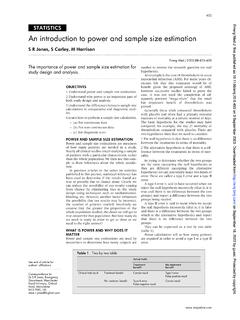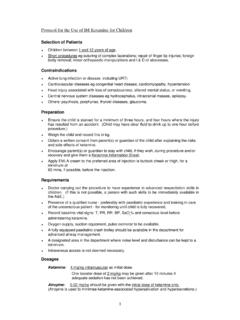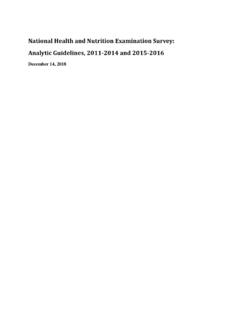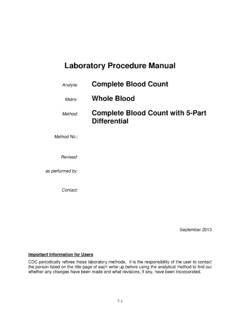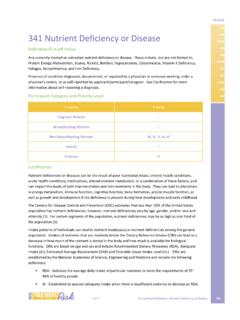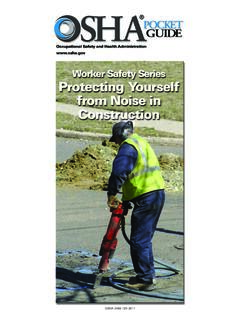Transcription of Mid-arm circumference can be used to estimate weight of ...
1 Mid-arm circumference can be used to estimateweight of adult and adolescent patientsGiles N Cattermole,1 Colin A Graham,2 Timothy H Rainer3 Additional material ispublished online only. To viewplease visit the journal online( ).1 Emergency Department,Centre Hospitalier Universitairede Kigali, Kigali, Rwanda2 Accident and EmergencyMedicine Academic Unit,Chinese University of HongKong, Shatin, Hong Kong3 Emergency Department,University Hospital of Wales,Cardiff, UKCorrespondence toDr Giles N Cattermole,Emergency Department, CentreHospitalier Universitaire deKigali, Kigali, 10 December 2015 Revised 29 October 2016 Accepted 24 November 2016To cite:Cattermole GN,Graham CA, Rainer Med JPublishedOnline First: [please includeDay Month Year] drug andfluid regimens inemergency medicine are weight dependent in adults, butno standard adult weight estimation tools weight is often estimated in emergencysituations using methods based on age or height whendirect measurement is not possible, and recently,methods based on Mid-arm circumference (MAC) havealso been developed.
2 The aim of this study was to deriveand validate an accurate MAC-based method for weightestimation for use in all age were obtained from the US NationalHealth and Nutrition Examination Survey (NHANES).MAC-based methods of weight estimation were derivedin 8498 subjects (5595 adults aged 16 80 years,2903 children aged 1 years) from the NHANES2011 2012 dataset, using linear regression. NHANES2009 2010 was used for validation in 9022 subjects(6049 adults aged 16 79 years, 2973 children aged1 years).ResultsA simplified method of MAC-based weightestimation was derived from linear regression equation: weight in kg=4 MAC (in cm) 50. On validation,results in children aged 1 years were poor. Inadults and children aged 11 years, over 60%,90% and 98% of estimates fell, respectively, within10%, 20% and 30% of actual weights when using thesimplified this description of a method forestimating weight in adults, we have derived andvalidated a simplified formula that is at least as precisein adults and adolescents as commonly used paediatricweight estimation tools in adult medicine, it is common practice (althoughunlikely to be good practice) for many drugs to begiven as a single adult dose, whether the patientweighs 50 or 100 kg.
3 However, many drugs used intime-critical situations do require more precisedosing according to weight , for example, localanaesthetics, induction agents, suxamethonium,gentamicin and other antibiotics or low molecularweight heparins. It is, therefore, important to esti-mate weight when it cannot be measured paediatric resuscitation, appropriate drug andfluid doses, equipment selection and ventilator set-tings are generally dependent on the weight of chil-dren. Because it is rarely possible to weigh a childin time-critical situations, it is customary to rely ona method of weight estimation and several toolshave been developed for this purpose. Most ofthese are age-based or height-based and are lessreliable with increasing drug andfluidregimens are weight dependent in all ages, but asyet there are no weight estimation tools for use formulae (ABF) for paediatric weightestimation include those used in the APLS APLS method uses two different formulaeaccording to the age group of the child, as definedby the child s age last birthday: for children aged1 5 years, weight in kg=(2 age)+8.
4 For childrenaged 6 12 years, weight in kg=(3 age)+7. Otherformulae have also been , none ofthese is reliable for children aged beyond 10 12 years. Wide ranges of weights for adults of thesame age preclude the use of ABF for most commonly used height-based methodof weight estimation is the Broselow tape (BT). Thelatest version of the tape extends to 150 cm, as wellas providing an estimate of weight according to theheight of children, and classifies children intocolour-coded groups corresponding to appropriatesets of equipment sizes and drug ,the tape is unsuitable for use in most children agedover 10 years. These older children are either tootall tofit the dimensions of the tape, or if they dofit, their height does not correlate with weight asstrongly as it does in younger forABF, wide ranges of weight for height in adults willpreclude the use of adult weight estimationmethods based on height circumference (MAC) is widely used asan indicator of childhood nutrition status inKey messagesWhat is already known on this subject?
5 There are several methods to estimate paediatricweight in emergency or resource-poor situationswhen direct measurement is not possible, butthere is no standard method of weight estimationin adults although many therapeutic interventionsin adults are also based on weight . Mid-armcircumference has been used as a basis forpaediatric weight estimation but it is not knownwhether this could be used in adolescents this study adds?Using the US National Health and NutritionExamination Survey, we have derived and validateda method of adolescent and adult weightestimation using Mid-arm circumference . This studyis based on pre-existing datasets and needs to bevalidated in a clinical GN,et Med J2016;0:1 6. article EMJ Online First, published on December 19, 2016 as Article author (or their employer) 2016. Produced by BMJ Publishing Group Ltd under licence. on June 27, 2023 by guest. Protected by Med J: first published as on 19 December 2016. Downloaded from resource-limited countries.
6 WHO guidelines use a cut-off cm as one criterion in the diagnosis of severe acute malnu-trition, and MAC is increasingly used in adolescents and adultstoo, especially in pregnant women and people living with MAC has long been known to correlate with weight ,no MAC-based weight estimation tool was published until2010. This was a simple formula derived in children of Chineseschool: weight in kg=(MAC in cm 10) 3. It performed as wellas BT in older children, but poorly in preschool , the Mercy Tape was developed, which uses a combinationof measurements of both MAC and humeral length to estimateweight, and was more precise than any other method in childrenaged 16 hypothesis was that MAC could provide the basis of anacceptable weight estimation tool for use in adults, adolescentsand children. This study therefore aimed to derive and validateMAC-based formula for weight estimation for use in all study was an analysis of publicly available National Healthand Nutrition Examination Survey (NHANES) datasets, down-loaded from the CDC website.
7 NHANES is a programme ofstudies designed to assess the health and nutritional status ofadults and children in the USA. It combines interviews andphysical examinations to collect health data for a nationally rep-resentative sample of the civilian population. Full details of theextremely in-depth sampling and examination methods areavailable on their included all subjects aged over 12 months and extractedage and anthropometric data for each subject, including weight ,height, MAC, upper arm length, upper leg length, waist circum-ference and sagittal abdominal diameter. weight was measureddigitally in kilograms, with subjects wearing a standard dispos-able gown and underwear. MAC was measured in the right armat the midpoint between the tip of the olecranon and the acro-mion, with the arm hanging used the latest available NHANES dataset ( 2011 2012)for analysisLMS Chartmaker Pro software (Cole and Pan, MedicalResearch Council UK, 2006) was used to model the relationshipof weight with MAC, according to the LMS method of Coleand each value (in cm) of MAC, the model pro-vides an estimate of the median weight in kilograms.
8 Twomodels were constructed. One model used separate analyses formale and female to provide different median weights for each(gender specific). The other model used a gender-weighted ana-lysis to provide single median weights for use in both male andfemale (gender neutral). MedCalc V. (MedCalcSoftware bvba, Belgium) was used for all other of weight with each of the different body measure-ments was determined using Pearson s correlation coefficient, r,with 95% CIs. Linear regression was used to define formulaerelating weight with validationThe NHANES 2009 2010 dataset was used as the validationset. weight was estimated for all subjects according to themodels developed in the derivation set. Bland-Altman analysis12was used to determine the accuracy of these estimates. Accuracycan be described in terms of trueness and precision. Trueness isthe measure of the average bias of the method in a given popu-lation. This is indicated by Bland-Altman bias, the mean per-centage difference between estimated and actual is a measure of the spread of estimates around thatmean.
9 This is indicated by Bland-Altman limits of agreement(LOA), defined as SD, the range within which 95% of thedifferences between estimated and actual weights will addition, for each subject, the difference between the esti-mate of weight and the true weight was expressed as an absolutepercentage error. The overall proportions of estimates witherrors of <10%, 20% and 30% were calculated for eachmethod. The 2testing was used to compare these proportionsbetween different age groups were defined as 1 , 6 , 11 and 16 years. The previous MAC- weight formula was derived inchildren aged from 1 to 11 years,1and the Mercy tape in chil-dren aged 16 age groups in this study were chosento reflect those cut-offs, divided equally into 5-year approval was not sought as the data were already pub-licly available online. No subjects were further involved, and nopatient identifiable data were obtained. There was also nofunding source for this total of 8498 subjects ( male) were included from theNHANES 2011 2012 dataset; 5595 adults (aged 16 80 years)and 2903 children (aged 1 years).
10 The ethnicity of thedataset reflected that of the US population distributions of the NHANES datasets wereassessed in terms of gender, age, MAC and weight . Derivation( 2011 2012) and validation (2009 2010) datasets are presentedin table 1. There was no significant difference in gender propor-tion (p= , 2test) as well as in mean age (p= , t-test).There were small differences in mean MAC ( cm, p= ,t-test) and weight ( kg, p= , t-test).Statistical analysisCorrelation of each body measurement with weight is shown intable 2. In both adults and children, the correlation of weightwas significantly stronger with MAC (overall; r= , 95% to ) than with the next best, waist circumference (r= , 95% CI to ).The relationship of MAC with weight was nearly linear(figure 1), with non-linearity at lower values of MAC (figure 2).Using the LMS method to model the data for bestfit, medianTable 1 Descriptive statistics of key variablesDerivation dataset (NHANES2011 2012)Validation dataset (NHANES2009 2010)n84989022 Male (%)4240 ( )4484 ( )Mean (SD) Median (IQR)Mean SD Median (IQR)Age (years) (11 52) (11 51) weight (kg) ( ) ( )MAC (cm) ( ) ( )All results are rounded to one decimal , Mid-arm circumference ; NHANES, National Health and Nutrition GN,et Med J2016;0:1 6.

